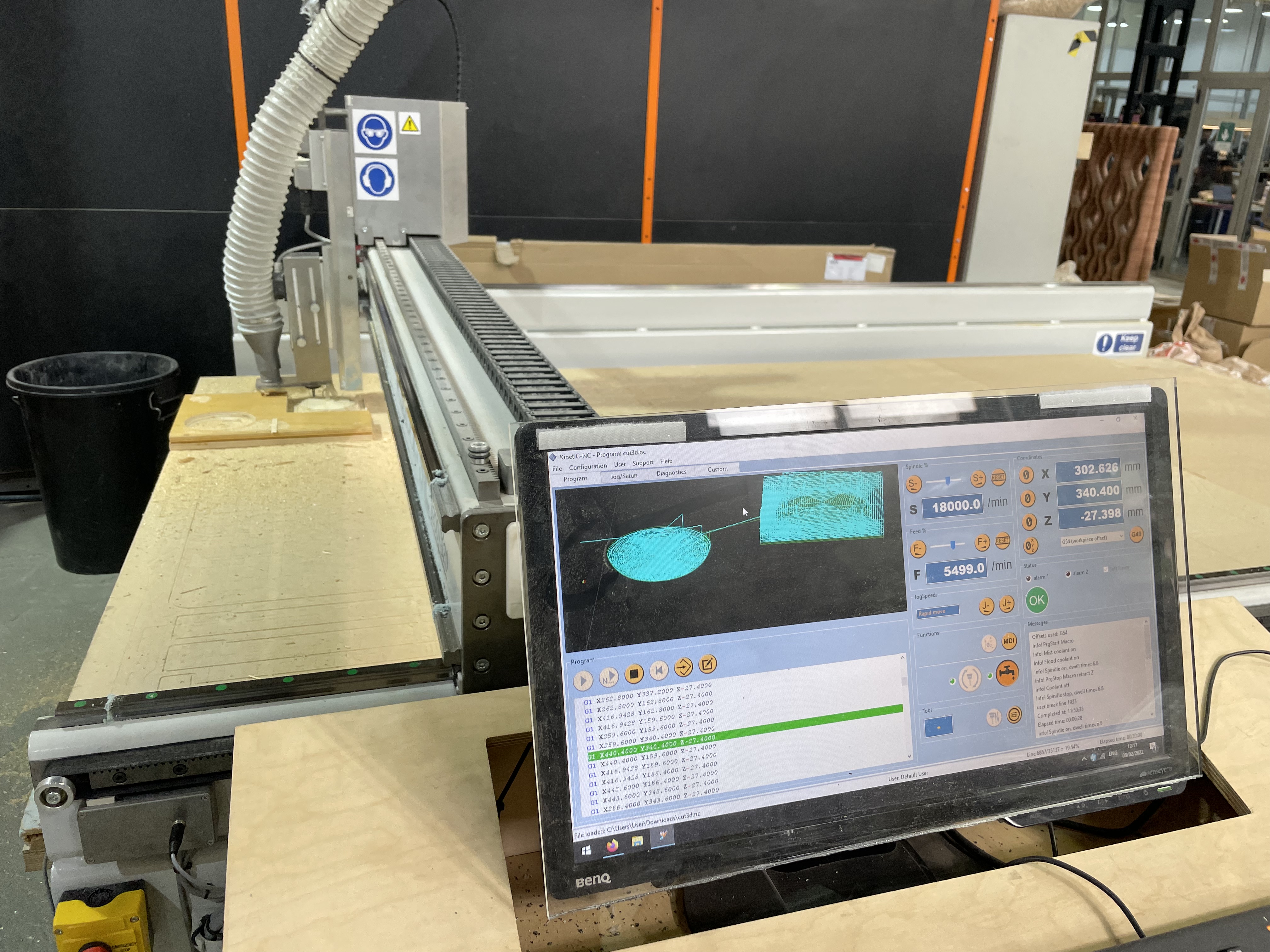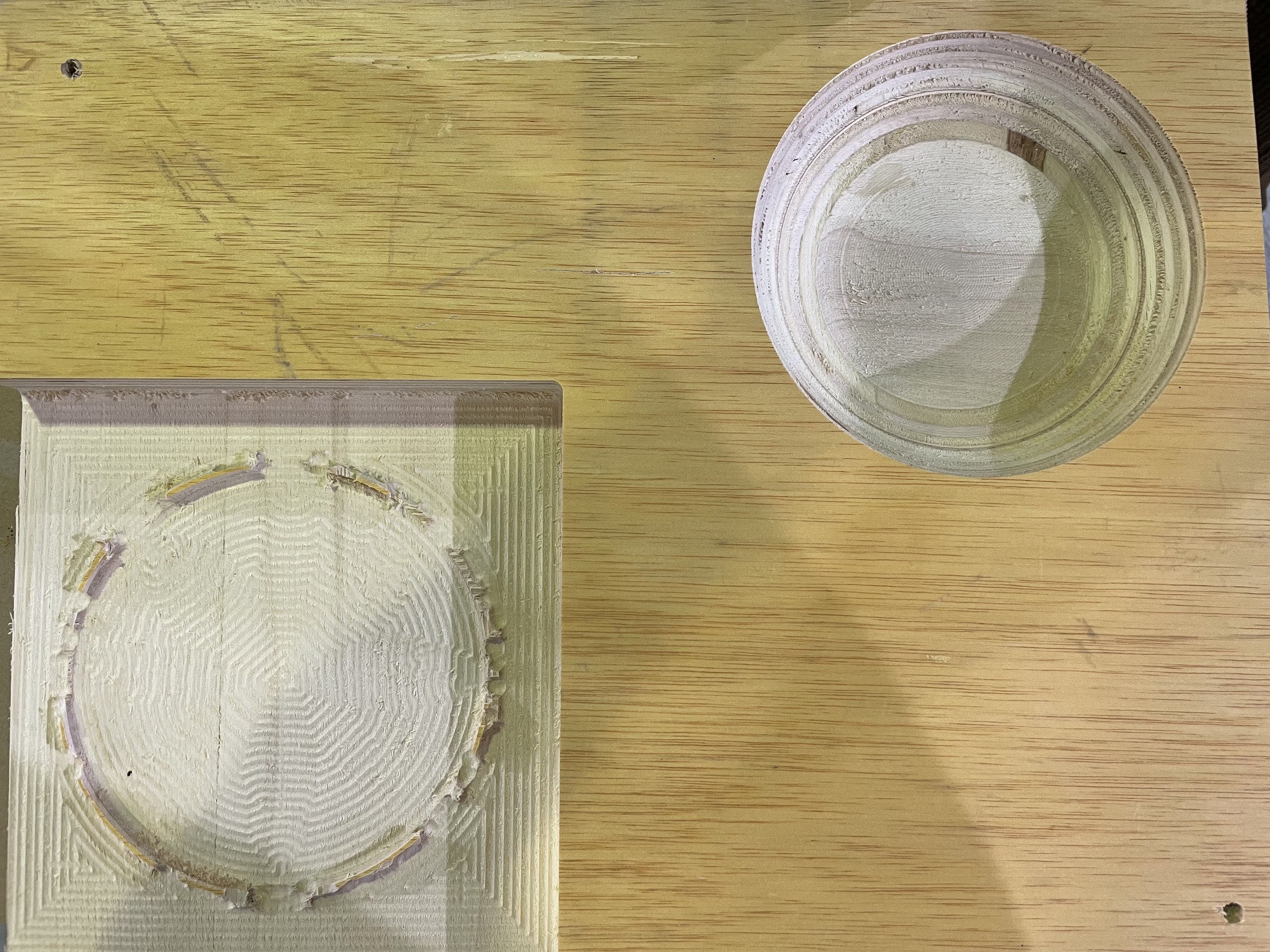About the Class
In today's class we learned about the basics of CNC-ing: What materials can be milled in which scenario and with which machines. Multiple examples for 2D and 3D milling were given.
CNC-milling a biomaterial mold
For the homework, George and me decided to mill a 3D mold to manufacture bowls from biomaterial. For this, we prepared a 3D file which was then checked by FabLab staff. Unfortunately the design didn't feature a watertight 3D volume but instead was an open shape. Therefore after perfectly milling our molds, the machine continued to drill into the finished positive and milled it down entirely. The result can be seen below. Let's just say it was a painful, but effective lesson on why to double check your 3D files before generating the g-code.

During the milling process using the Raptor CNC.

The finished piece. In the bottom left, the destroyed positive can be seen clearly.
Further Links
projects
Standing Desk, Opendesk, AtFab
Shelter 2.0, yourHOUSE, Wikihouse, FabHouse, Fab Lab House
10,000 Year Clock
machines
Shaper
Maslow
ShopBot
Onsrud
Tormach
Haas
Hurco
Zund
MTM
Fellesverkstedet
stock
cardboard
rigid foam insulation (gesso, heat gun)
veneer plywood
Medium Density Fiberboard (MDF)
Medium Density Overlay (MDO)
Oriented Strand Board (OSB), finishing, covering
Valchromat
HDPE
Lexan, polycarbonate
Garolite
Aluminum (Composite Panel)
vendors
McMaster-Carr
US Plastics
Admiral Metals
Home Depot
Boulter Plywood
Steritt Lumber
Beacon Sales
job shops
Proto Labs
Star Rapid
Yubo Precision
DSH
Cycle Start
Fast Forward Composites
Xometry
tooling
drills vs mills
router, V bits
flutes
coatings
center-cutting
up/down cut
flat/ball end
speeds and feeds
chip load: ~ 0.001-0.010"
feed rate (inches per minute) / (RPM x number of flutes)
cut depth: ~ tool diameter
step-over: ~ tool diameter/2
lubricants
abrasive machining, grinding
fixturing
vises
bar clamps
screws
nails
vacuum
wedges
weights
glue
tape
encapsulation
sacrificial layers, squaring
dust collection
flexures, living hinges, kerfing,
steam bending,
wacky wood
fasteners,
glues
joinery, reciprocal frame, tensegrity, Maxwell criterion
toolpaths
kerf, offset, runout
conventional, climb
rough/finish cuts
high-speed, dry, ramping, adaptive clearing, swarf, rest, trochoidal
one-sided, two-sided, registration
2, 2.5, 3, 4, 3+2, 5 axis
tool length compensation
cut depth, clearance, collisions
T-bones, dog-bones
tabs, onion skinning
nesting
lead-in, -out
test cuts, cutting air
simulation
prototyping
CAM
CAMotics
VCarvePro
FeatureCAM
Mastercam
HSMWorks
CAMWorks
Freecad Path
Solidworks CAM
Fusion 360
OpenBuilds
mods
community
outline
rough
finish
file formats
.rml
.sbp
.g
.ord
safety
training
splinters, cuts, burns, impacts, fires
tool breaking
glasses, shoes, clothes, hair, gloves
look, listen, smell
don't reach into a powered tool
emergency stop, assistance
personal state
welding
arc
MIG (metal inert gas)
TIG (tungsten inert gas)
spot
friction
ultrasonic
assignment
group assignment
do your lab's safety training
test runout, alignment, fixturing, speeds, feeds, materials, and toolpaths for your machine
individual assignment
make (design+mill+assemble) something big (~meter-scale)
extra credit: don't use fasteners or glue
extra credit: include curved surfaces